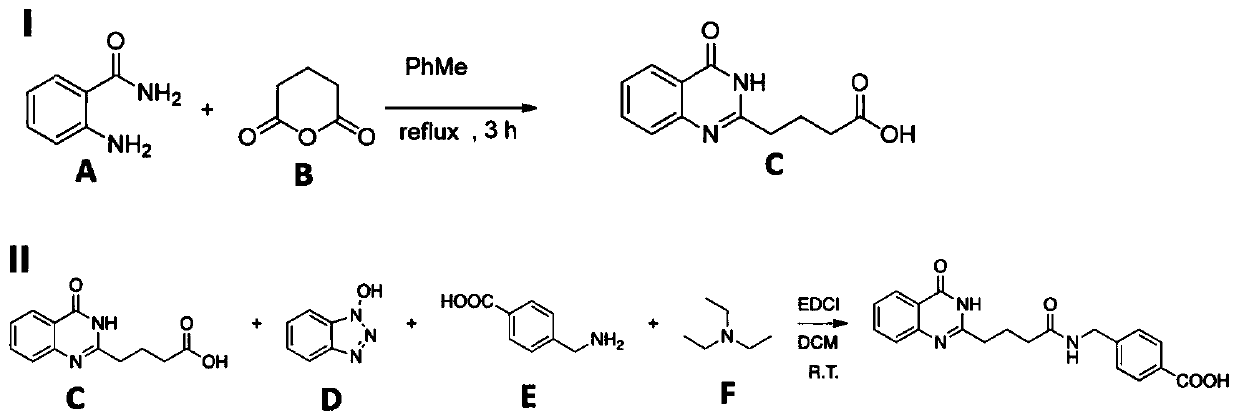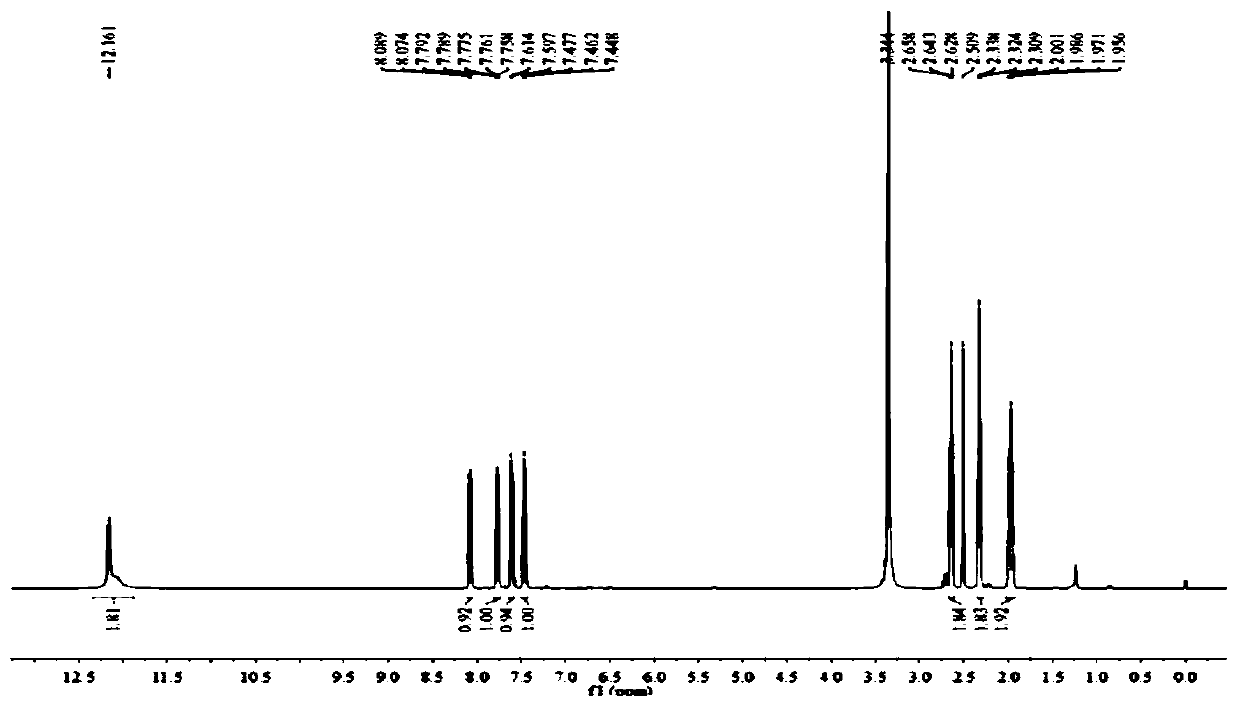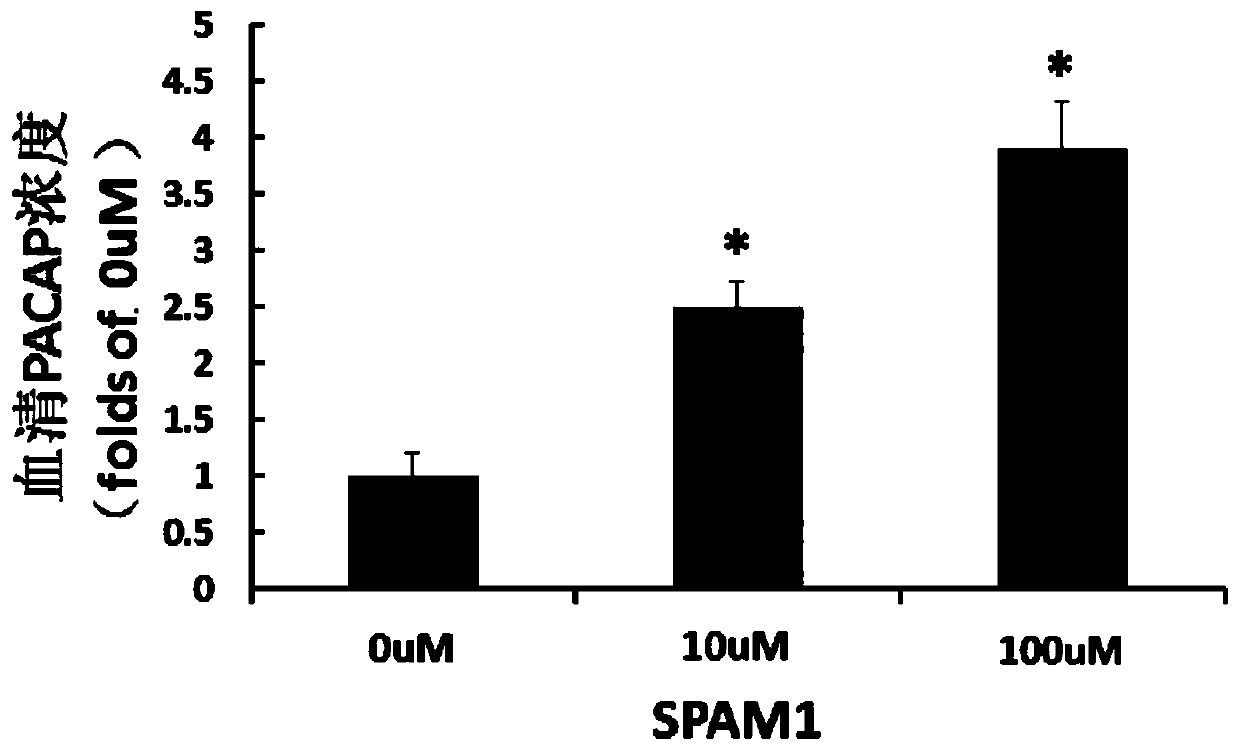Small molecular compound SPAM1 for up-regulating neuropeptide PACAP and receptor PAC1-R thereof and preparation method and application thereof
A technology of small molecular compounds and neuropeptides, applied in nervous system diseases, medical preparations containing active ingredients, drug combinations, etc., can solve the problems of limitation, poor in vivo stability of PACAP, limited function of crossing biological barriers, etc. Small effect with few side effects
- Summary
- Abstract
- Description
- Claims
- Application Information
AI Technical Summary
Problems solved by technology
Method used
Image
Examples
Embodiment 1
[0037] Embodiment 1: the pilot test synthetic technique (two-step method) of SPAM1
[0038]according to figure 1 As shown, a two-step synthesis was adopted. Step 1: In a 150 mL flask equipped with a condenser, benzamide A (5.45 g, 40.0 mmol, 1.0, etc.) and amber hydride B (4.00 g, 40.0 mmol, 1.0, etc.) were mixed in 50 mL of toluene middle. The suspension was vigorously refluxed for 3 hours and then cooled to room temperature. The resulting product C was filtered as a white solid, washed with Et2O and dried (8.833 g, 88.3% yield). Product NMR detection as figure 2 shown.
[0039] Step 2: Synthesize according to the following feeding ratio:
[0040] project code C D E F EDCI DCM Source number (g) 10.00 5.82 6.51 13.07 9.08 200mL Molar equivalent (eq) 1.0 1.0 1.0 3.0 1.1 20mL / g
[0041] At room temperature, add C and D successively to the 500mL reaction flask, then add the solvents DCM and F, and stir. Add shrinkage agent ED...
Embodiment 2
[0042] Example 2: SPAM1 effectively up-regulates the level of PACAP in the body
[0043] 30 BALb / c mice, SPF grade, 8-10 weeks old, 22-27g in weight, half male and half male, were randomly divided into 3 groups, 10 mice in each group: 1) SPAM1 low-dose group, intraperitoneal injection of 10umol / kg ; 2) SPAM1 high-dose group, intraperitoneal injection of 100umol / kg; 3) normal control group, intraperitoneal injection of normal saline; 30 minutes after injection, blood was collected from the orbit, and the serum was detected by ELISA kit for PACAP. The result is as Figure 4 As shown, SPAM1 effectively up-regulates the content of PACAP in serum, and the up-regulation effect is concentration-dependent.
Embodiment 3
[0044] Example 3: SPAM1 effectively up-regulates the expression of PACAP-specific receptor PAC1-R
[0045] Neuro2a, a mouse neuron cell naturally expressing PAC1-R, was cultured until the fusion rate was above 80%, and 1uM-100uM SPAM1 was added, and after incubation for 1h, the cells were broken; the supernatant of the whole cell lysate was subjected to SDS-PAGE and anti-PAC1- The antibody at the C-terminal of R was detected by western blot. The result is as Figure 5 As shown, 1uM, 10uM and 100uM of SPAM1 up-regulated the expression of PAC1-R in nerve cells in a concentration-dependent manner.
[0046] The human nerve cell SHSY-5Y that naturally expresses PAC1-R was cultured to a fusion rate of over 80%. After incubation with 100uM SPAM1 for 1 hour, confocal immunofluorescence observation was performed: DAPI staining of the nucleus was purple blue, while the red color targeting PAC1-R The fluorescent signal was significantly upregulated by SPAM1 ( Figure 6 ).
PUM
 Login to View More
Login to View More Abstract
Description
Claims
Application Information
 Login to View More
Login to View More - R&D
- Intellectual Property
- Life Sciences
- Materials
- Tech Scout
- Unparalleled Data Quality
- Higher Quality Content
- 60% Fewer Hallucinations
Browse by: Latest US Patents, China's latest patents, Technical Efficacy Thesaurus, Application Domain, Technology Topic, Popular Technical Reports.
© 2025 PatSnap. All rights reserved.Legal|Privacy policy|Modern Slavery Act Transparency Statement|Sitemap|About US| Contact US: help@patsnap.com



